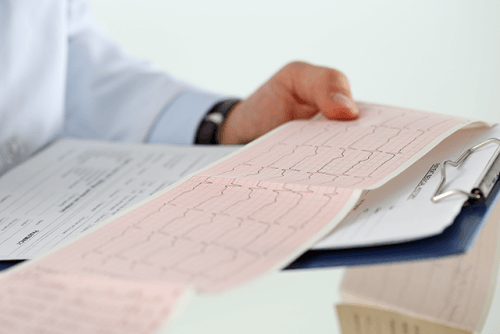What You Didn't Know about Cardiac Arrhythmias

Cardiac arrhythmias affect many people. For this reason, we’ve talked a lot about them in Step to Health in the past. However, there are some aspects that you may not yet know about them.
As the Spanish Heart Foundation points out, cardiac arrhythmias are heart rhythm alterations. If your heart beats too fast, too slow, or has an irregular rhythm, these are signs that alert you to their presence.
Next, we’ll explain some aspects of cardiac arrhythmias that you must keep in mind. This is important since this condition affects more than 50% of the population.
All about cardiac arrhythmias
Electrophysiology: an effective test

Electrophysiology is a test that medical professionals request to diagnose those with arrhythmias. It allows them to determine the type of arrhythmia a patient’s suffering from, its severity, exactly where it’s occurring, and the disorders it’s causing.
This test is very important, since it allows medical professionals to adjust the treatment to avoid wasting time trying options that won’t improve the patient’s problem. It’s a technique that’s having a lot of success and yielding great results.
The risk of sudden death from cardiac arrhythmias is high
Sudden death is caused, in most cases, by cardiac arrhythmias. Specifically, ventricular fibrillation arrhythmias and ventricular tachycardia arrhythmias.
These types of arrhythmias are often referred to as “malignant” due to their high risk of sudden cardiac arrest. If this occurs, treatment should be applied as soon as possible with ventricular defibrillation.
Read on to learn more: Artificial Hearts Promise to Help Patients Without Donors
Not all arrhythmias are equally dangerous

Despite the fact that some types of cardiac arrhythmias pose a risk of sudden death, this doesn’t mean that they’re all equally dangerous. This is why electrophysiology is so important. With this test, medical professionals can get to know the severity of the arrhythmia that the patient’s suffering from.
- Premature heartbeat. This is an out-of-time beat, ahead of the patient’s heart rate. Normally, this isn’t serious. Nevertheless, it requires a medical follow up. It’s usually treated with diet and lifestyle changes.
- Sinus bradycardia. Heart rate slows, is irregular, and may stop at times. In some cases, it may not require any treatment. However, if it worsens, the patient may need to use a pacemaker.
- Ventricular fibrillation. This is a type of heart disease that we mentioned above. It can endanger the patient’s life, causing them to suffer sudden cardiac arrest that can lead to death.
There are many other types of arrhythmias, such as heart blockages or paroxysmal supraventricular tachycardia. The important thing is to realize that they’re not equally serious nor require treatment. In fact, in some, monitoring and control is more than enough.
This article may interest you: Characteristics of Congenital Heart Disease
Treatments are diverse
Just as not all cardiac arrhythmias are equally severe, the same goes for treatments. As we mentioned above, in some cases, the only treatment is only adequate follow-up and control. Nevertheless, other patients may need to quit harmful habits, such as smoking or alcohol and improve their diet.
However, it’s true that arrhythmias often need to be treated with drugs. But they aren’t all the same. Everything will depend on the patient, the type of arrhythmia they’re suffering from, and its severity.
Furthermore, there’s a treatment known as “radiofrequency ablation” that’s usually applied after the electrophysiological study. The goal of this treatment is to eradicate the arrhythmia with a small burn that destroys the heart tissue that’s causing the arrhythmia. Currently, it’s yielding excellent results.
Did you know all these facts about cardiac arrhythmias? Had you heard about some but didn’t know too much about them? Although we’ve dealt with this topic on different occasions, you can always delve deeper to learn more.
Also, remember that researchers continue to investigate new ways of treating this condition. Therefore, although we’ve mentioned several treatments, some new ones may appear later that, without a doubt, we’ll share with all of you.
All cited sources were thoroughly reviewed by our team to ensure their quality, reliability, currency, and validity. The bibliography of this article was considered reliable and of academic or scientific accuracy.
- (2007). BRADICARDIA SINTOMÁTICA Y USO DE MARCAPASOS EN EL SERVICIO DE URGENCIAS. Revista de la Facultad de Medicina, 55(3), 191-208. Retrieved January 22, 2019, from http://www.scielo.org.co/scielo.php?script=sci_arttext&pid=S0120-00112007000300007&lng=en&tlng=es.
- Gómez Flores, Jorge. (2009). Arritmias cardiacas. Archivos de cardiología de México, 79(Supl. 2), 2. Recuperado en 22 de enero de 2019, de http://www.scielo.org.mx/scielo.php?script=sci_arttext&pid=S1405-99402009000600002&lng=es&tlng=es.
- Pérez, Gerardo, & Alonso Bao, Juan. (2014). Cuando el motivo de consulta son las palpitaciones, ¿cómo continuar?. Archivos de Medicina Interna, 36(2), 68-74. Recuperado en 22 de enero de 2019, de http://www.scielo.edu.uy/scielo.php?script=sci_arttext&pid=S1688-423X2014000200005&lng=es&tlng=es.
- Rodríguez-Reyes, Humberto, Muñoz Gutiérrez, Mayela, Márquez, Manlio F., Pozas Garza, Gerardo, Asensio Lafuente, Enrique, Ortíz Galván, Fernando, Lara Vaca, Susano, & Mariona Montero, Vitelio August. (2015). Muerte súbita cardiaca. Estratificación de riesgo, prevención y tratamiento. Archivos de cardiología de México, 85(4), 329-336. https://dx.doi.org/10.1016/j.acmx.2015.06.002
- Ventura, Alejandro, Soriano, Lisandro, López, Marisa, & Enciso, Elizabeth. (2012). Ablación por radiofrecuencia de una taquicardia ventricular tras la cirugía reparadora de la tetralogía de Fallot. Revista argentina de cardiología, 80(1), 60-64. Recuperado en 22 de enero de 2019, de http://www.scielo.org.ar/scielo.php?script=sci_arttext&pid=S1850-37482012000100012&lng=es&tlng=es.
This text is provided for informational purposes only and does not replace consultation with a professional. If in doubt, consult your specialist.








